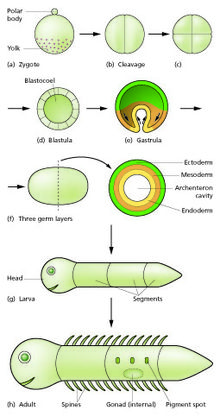
In developmental biology, animal embryonic development, also known as animal embryogenesis, is the developmental stage of an animal embryo. Embryonic development starts with the fertilization of an egg cell (ovum) by a sperm cell (spermatozoon).[1] Once fertilized, the ovum becomes a single diploid cell known as a zygote. The zygote undergoes mitotic divisions with no significant growth (a process known as cleavage) and cellular differentiation, leading to development of a multicellular embryo[2] after passing through an organizational checkpoint during mid-embryogenesis.[3] In mammals, the term refers chiefly to the early stages of prenatal development, whereas the terms fetus and fetal development describe later stages.[2][4]
The main stages of animal embryonic development are as follows:
- The zygote undergoes a series of cell divisions (called cleavage) to form a structure called a morula.
- The morula develops into a structure called a blastula through a process called blastulation.
- The blastula develops into a structure called a gastrula through a process called gastrulation.
- The gastrula then undergoes further development, including the formation of organs (organogenesis).
The embryo then transforms into the next stage of development, the nature of which varies among different animal species (examples of possible next stages include a fetus and a larva).
- ^ Gilbert, Scott (2000). Developmental Biology. 6th edition. Chapter 7 Fertilization: Beginning a new organism. Retrieved 3 October 2020.
- ^ a b Gilbert, Scott (2000). Developmental Biology. 6th edition. The Circle of Life: The Stages of Animal Development. Retrieved 3 October 2020.
- ^ Drost, Hajk-Georg; Janitza, Philipp; Grosse, Ivo; Quint, Marcel (2017). "Cross-kingdom comparison of the developmental hourglass". Current Opinion in Genetics & Development. 45: 69–75. doi:10.1016/j.gde.2017.03.003. PMID 28347942.
- ^ Gilbert, Scott (2000). Developmental Biology. 6th edition. Early Mammalian Development. Retrieved 3 October 2020.